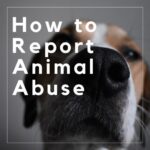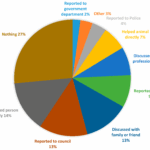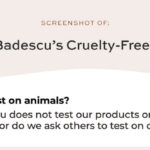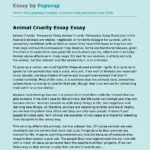As animal advocates, our commitment to ending cruelty towards animals requires us to spread awareness effectively. Utilizing social media, particularly Facebook, presents an opportunity to rally support, share information, and confront injustices faced by innocent creatures. However, with the vast reach of social platforms, do we ever stop to ponder the potential ramifications of how we share such sensitive content? Can we strike a balance between shock value and responsibility? While it may be tempting to unleash a barrage of harrowing images, our approach should be meticulously crafted to foster engagement without desensitizing our audience.
First and foremost, understanding the nature of animal cruelty itself is crucial. Animal cruelty can manifest in various forms, such as neglect, physical abuse, and exploitation. Each of these categories requires specific strategies when posted on social media. Whether one shares a personal account highlighting a rescued animal’s plight or general information about systemic issues, clarity and accuracy of presentation are paramount.
One of the most effective ways to create impactful posts is to adopt a narrative-driven format. Instead of resorting solely to graphic images that may instill dread, consider telling the story of a particular animal. Describe the circumstances—they might have faced abandonment, mistreatment, or abuse. Rich, descriptive language can paint a picture sharper than any photograph. By giving voice to the voiceless, you not only inform your audience but also evoke empathy and connect on a personal level.
Leverage the power of visuals judiciously. Although captivating images can draw attention, they should be accompanied by thoughtful content. It’s essential to preface shocking images with trigger warnings, lest your audience experiences undue distress. For example: “Below is a difficult image to view, but it underscores the critical need for change.” Providing context for images adds a layer of understanding and responsibility. Moreover, consider using creative graphics or infographics that summarize key statistics or facts about animal cruelty. These can be both informative and engaging, inviting readers to share further.
Another tactic to consider is engaging your followers through interactive content. Pose open-ended questions that encourage dialogue and reflection: “What steps can we take collectively to combat animal cruelty?” This not only prompts a conversation but also fosters a sense of community among animal advocates. When individuals feel they are part of a solution, they are more likely to share your message and amplify the cause.
Further enhancing your posts can involve collaborating with reputable organizations that focus on animal welfare. Sharing resources from trusted organizations lends credibility to your message. In addition, you can solicit expert opinions or quotes related to the subject matter, establishing authority on the topic. This provides a well-rounded view and encourages followers to explore more about the issues at hand effectively.
Furthermore, timing is critical in the realm of social media. The effectiveness of your message can depend on various factors, including current events, awareness months, or trending topics related to animal welfare. Participating in these discussions can significantly expand the reach of your message. Find ways to seamlessly connect your posts to current events, highlighting why these moments are significant for animal rights.
Equally important is addressing counterarguments with grace and poise. When sharing posts about animal cruelty, it’s inevitable that not everyone will agree with your perspective. Anticipate dissent and prepare responses that are informative, rational, and respectful. Engaging thoughtfully with critics can transform potential conflicts into constructive discussions, showcasing your commitment to advocacy.
Monitoring the analytics of your posts is also a beneficial practice. Understanding what type of content resonates with your audience can help refine your approach. Pay attention to the engagement rates—likes, shares, comments—to gauge what has the most impact. Use this data to inform future posts and optimize your outreach efforts.
Finally, encourage your followers to take action. Sharing information about petitions, donations, and volunteer opportunities can turn awareness into tangible change. Providing a direct avenue for support empowers your audience to become advocates rather than passive observers. An informative post followed by a clear call to action can elevate awareness from mere conversation to proactive engagement.
In conclusion, posting about animal cruelty on Facebook necessitates a balance of emotion and responsibility. As advocates for those without a voice, it’s imperative that we craft our messages with care and thoughtfulness. By focusing on narratives, leveraging visuals judiciously, encouraging dialogue, and promoting actionable solutions, we can create a powerful, effective force against animal cruelty. Are you ready to embark on this journey with us? Your actions can make a difference—step forward and take up the mantle of responsibility today.









